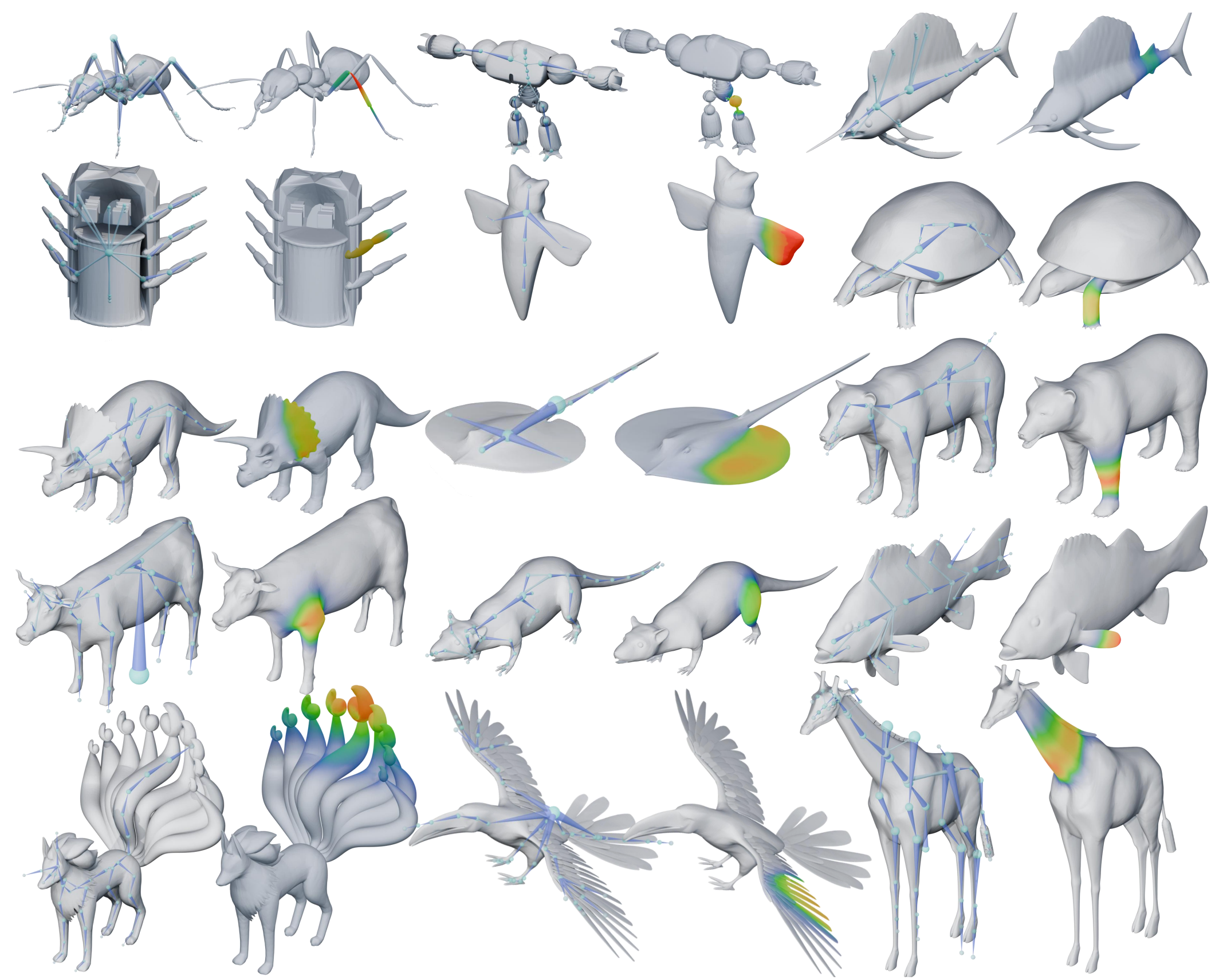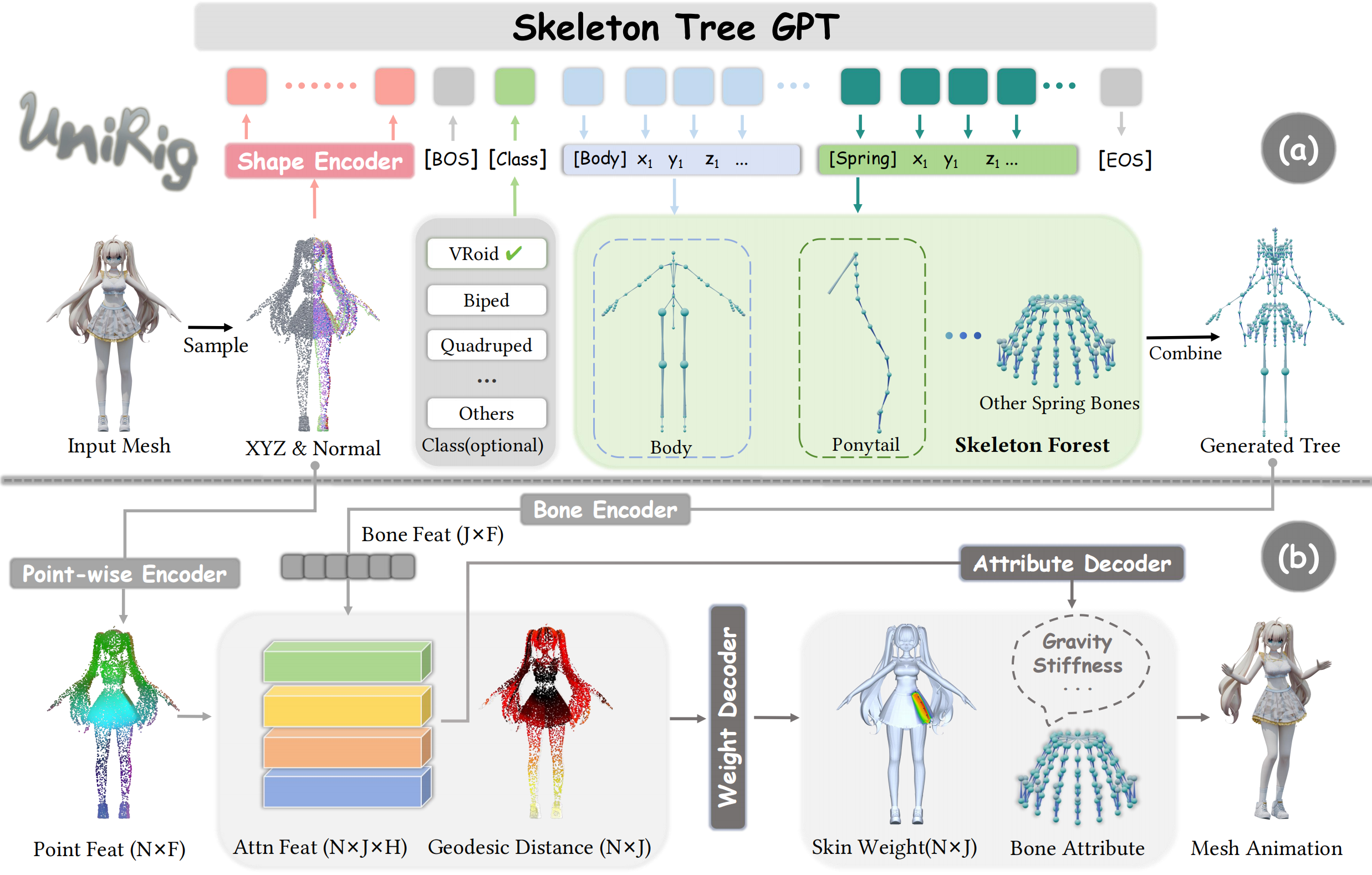VAST-AI and Tsinghua University Open Source UniRig: A Framework for Automatic Skeleton Rigging of All 3D Models

The joint research team from VAST-AI (Tripo) and Tsinghua University has recently open-sourced UniRig, a framework designed to revolutionize automatic skeleton rigging for 3D models. This technology marks an important breakthrough in the field of computer graphics, utilizing the powerful capabilities of large autoregressive models to generate high-quality skeleton structures and skinning weights for diverse 3D models, solving one of the most challenging aspects of animation workflows.
Solving the Core Bottleneck in 3D Content Creation
With the prosperity of metaverse, game development, and digital content production, the demand for 3D models is experiencing explosive growth. However, the process of converting static models to animatable characters through skeleton rigging has remained a significant bottleneck—requiring not only time but also specialized skills.
Professional character riggers need to spend hours or even days creating skeletal hierarchies for complex models, then meticulously adjust weights to ensure natural deformation. For beginners, this process has a steep learning curve, and even for professionals, it remains one of the most time-consuming aspects of the workflow.
Existing automatic rigging tools mainly fall into two categories:
- Template-based methods: While relatively reliable for standard humanoid characters, they often fail when faced with novel forms (such as multi-legged creatures, mechanical structures, or fantasy creatures)
- Template-free methods: Though more flexible, the generated skeletal topologies often don’t meet artists’ expectations, and control precision is limited
UniRig: One Model to Rig Them All
UniRig introduces a new paradigm for automatic skeleton rigging by applying the concepts of large language models (LLM). The research team treats skeletal structures as a special “language,” enabling the model to “understand” and “generate” the inherent skeletal logic of various creatures and objects.

UniRig’s innovations include:
1. Innovative Skeleton Tree Tokenization Mechanism
Skeleton Tree Tokenization is the core innovation of UniRig, solving the challenge of encoding skeletal structures with complex hierarchical relationships into linear sequences. This scheme intelligently encodes:
- Joint coordinates: Representing spatial positions in discretized form for geometric precision
- Hierarchical structure: Clearly defining parent-child relationships to ensure valid skeletal trees
- Semantic information: Identifying different types of bones through specialized tokens (such as main bones, IK controllers, auxiliary physics bones, etc.)
This design reduces sequence length by approximately 30% compared to traditional methods, significantly improving model efficiency and generation quality.
2. Two-Stage Architecture Ensures High-Quality Results
UniRig employs a carefully designed two-stage architecture:
-
Skeleton Generation Stage: A GPT-based Transformer generates joints one by one through autoregression, forming a complete skeletal hierarchy. This process considers both global and local geometric features, ensuring that the skeleton closely matches the 3D model’s form.
-
Skinning Weight Prediction Stage: Through an innovative “Bone-Point Cross Attention” mechanism, UniRig can precisely calculate how each model vertex is influenced by surrounding bones, generating natural, smooth skinning weights. The system can also predict physical parameters for specialized bones (such as spring coefficients for physics bones), supporting advanced animation effects.
Rig-XL Dataset: Driving Generalization Through Diversity
To support UniRig’s training, the research team built Rig-XL, the largest skeleton rigging dataset to date, containing over 14,000 diverse rigged 3D models. This dataset covers:
- Humanoid characters (realistic and cartoon styles)
- Quadrupeds (domestic animals, wildlife, fantasy creatures)
- Birds and flying creatures
- Insects and arthropods
- Mechanical structures and non-organic objects
- Anime-style characters (including physical spring bones)
By training on such diverse data, UniRig gained powerful generalization capabilities, able to handle various unseen model forms.
Performance Advantages in Production
In multiple comparative tests, UniRig significantly outperformed existing commercial and academic solutions:
- Binding accuracy improved by 215%: Bone positions and hierarchical structures better match professional artists’ expectations
- Animation quality improved by 194%: Generated weights produce more natural and fluid deformations during animation
- Processing capabilities greatly expanded: Successfully handles forms ranging from simple to extremely complex (such as multi-legged insects or multi-limbed fantasy characters)
- High efficiency: Most models are processed within 1-5 seconds, far less than the time required by professional riggers
Potential Integration with ComfyUI Workflow
As generative AI models like TripoSG and TripleSF are applied in ComfyUI, generating high-quality 3D models has become possible. However, generated models typically lack skeletal structures, limiting their application in animation.
UniRig has the potential to seamlessly integrate with ComfyUI’s 3D generation workflow, enabling an end-to-end process from creative concept to animatable character:
- Generate 3D models using text or image prompts
- Automatically add skeletal structures through UniRig
- Export to any software or game engine that supports skeletal animation
Furthermore, combined with the HoloPart technology released yesterday, it can enable component-level editing and skeleton generation of models, providing creators with unprecedented flexibility.
Current Open Source Status
VAST-AI has begun to gradually open source the various components of UniRig:
- ✅ Already open-sourced: Skeleton prediction model (trained on Articulation-XL2.0)
- ⏳ Coming soon: Skinning weight prediction model
- ⏳ Coming soon: Rig-XL and VRoid datasets
- ⏳ Coming soon: Complete UniRig model checkpoints trained on Rig-XL/VRoid
Creator Feedback and Open Source Community Participation
Independent 3D artists who tested UniRig early stated that the technology “significantly changed the creative process” and “opened the door to animation creation for non-professional riggers.” A game developer commented: “UniRig can complete in seconds what previously took hours, and the quality is even better.”
VAST-AI invites the open source community to participate in the further development of UniRig, especially in the following areas:
- Specialized fine-tuning for specific types of models
- Plugin integration with existing 3D creation software
- Optimized lightweight models for smaller devices
Related Links
VAST-AI has been frequently open-sourcing multiple 3D creation-related projects recently, including UniRig introduced today, HoloPart, TripleSF, as well as MIDI and MV-Adapter for end-to-end generation of three-dimensional composite scenes from single images, continuously leading the direction of 3D generation technology and providing more powerful tools for the creative community.